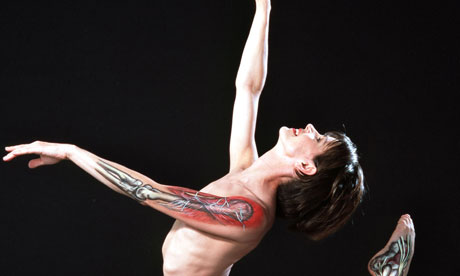
Darcey Bussell was taught the lead role in Stravinky's The Firebird by Monica Mason, who was taught it by Margot Fonteyn, who had been coached by Tamara Karsavina, the Russian ballerina for whom the role was created in 1910. That's nearly 100 years right there. Deborah Bull's The Everyday Dancer reveals ballet to be an inherited culture that surpasses language, danced by a family that spans countries and generations.
From the purpose-built spaces of White Lodge to the room above the Skegness fish and chip shop where Bull began her artistic life, the tradition of the older body teaching the younger body thrives. The art of ballet, so predicated on physical denial, is described here by a writer whose loyalty to its customs operates as a kind of veil over its everyday pain. Abstracted into a life-in-the-day structure, this memoir hints at personal ambivalence, but doesn't dwell on the years of hunger and dancing with chronic injuries. Just one page is devoted to an eating disorder that "affected half my career", compared to seven pages on the rituals of preparing ballet shoes.
English ballet only really caught on between the wars and the tone of that era – a sense of propriety and a stoical tolerance for suffering – is present in the writing. Bull minimises the personal costs of serving such an ambitious tradition because, like all professional dancers, she is a trouper.
Maybe she is wary of the media that will misconstrue this curious and old-fashioned discipline as a form of torture. As she rightly asserts, the pressure to be lean comes from everywhere: critics, audiences, dancers themselves. Bull's succinct summary – "There is no reason for any of us to be missing lunch" – is spoken like a true ballet mistress, presumably to a readership of young dance hopefuls, who one hopes will take heed and not nod agreement while making other plans. Though a complicity of deprivation operates in ballet – the studio culture of silence and mirrors rewards dancers who pursue a rare ideal – Bull's conclusion seems to be: masochism is a personal choice.
The story of all dancers is the story of growing up. Bull begins as a little girl who acquiesces to her father's wish that she "dance nicely", only to realise that art must be anything but nice. Ballet seeks uniformity as a goal yet rewards those who dare to be different. In one of the book's saddest passages, Bull admits that she and a US counterpart – fellow ballerina Cynthia Harvey – share a deep sense of betrayal when they realise, shockingly late, that their propensity for obedience has thwarted their ambitions. The loss for Bull is profound: seeing one's youth from the powerless position of retrospect and the knowledge that the art to which she gave her whole self to was not always true in return.
Dancers will delight in the dissection of "class", the defining ritual that permits only a mirror and one's thoughts for company. Bull does a wonderful job of articulating the bravado, fears and vanities that breed within four walls. Dance class's ultimate strangeness is its solitude. The peculiar garb dancers wear, asymmetrical add-ons that disguise real or imagined physical shortcomings, seems to be a natural consequence of over-using a mirror. It is creepy what aloneness does to a person.
The revelation of this book is the pleasure uniformity yields. It turns out that dancing in the corps de ballet, the lowest position in the hierarchy (up to 20 of you in unison on one leg, dressed as, say, peasants), is probably the most satisfying. While soloists get the bouquets and the glory, the corps gets each other. Bull's descriptions of the camaraderie and togetherness – even the sacrificing of self – sound like fun. Success brings isolation; the international tours demand that the principal stars slave days away onstage, while the corps, on afternoons off, get to photograph each other in front of the Eiffel Tower.
Dancers counter the daily reality of rejection with discipline. Others get chosen instead of you, but practice can transform what you were born with, and tomorrow is up for grabs. Dancers need relentless self-confidence and, like Bull, a great family. Without these essentials, individuals are vulnerable to the "dubious dressing room wisdom" that children pass among themselves. Bull's artistic voice – formed from a career that balanced fame and mundane repetition – is calm. To be an everyday dancer takes maturity of mind and a true understanding of the difference between seeing and being.
Fleur Darkin is a choreographer (darkinensemble.com). Her new work, The Blake Diptych, previews at Laban, London SE8 on 9-10 November and then tours nationally.

